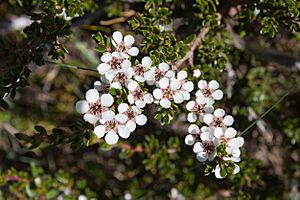Alpine tea-tree facts for kids
Quick facts for kids Alpine tea-tree |
|
|---|---|
 |
|
| Leptospermum rupestre, Walls of Jerusalem National Park |
|
| Scientific classification | |
| Genus: |
Leptospermum
|
| Species: |
rupestre
|
| Synonyms | |
|
|
Leptospermum rupestre, also known as the alpine tea-tree or prostrate tea-tree, is a cool flowering shrub. It belongs to the Myrtaceae family, which includes plants like eucalyptus. This special plant grows only in Tasmania, Australia. In very high, cold areas, it often grows flat along the ground. But in slightly lower, warmer places, it can become a bigger bush.
What it Looks Like
Leptospermum rupestre is a common shrub found in Tasmania's high mountains and subalpine areas. How it grows depends on where it lives. In very high, windy places, it stays low, growing flat along the ground. It can be up to 1 meter (about 3 feet) tall.
In lower, less exposed areas, it can grow into a larger shrub. Here, it might reach up to 4 meters (about 13 feet) high. Its leaves are small, blunt, and shiny dark green. They are oval or elliptic in shape and measure 2 to 9 millimeters long.
In summer, this plant produces many small white flowers. Each flower is about 1 centimeter (less than half an inch) wide and has five petals. They bloom openly from where the leaves meet the stem. The branches are reddish and often form a mat over rocks. After flowering, small seed capsules appear, which are about 5 millimeters across.
How it Got its Name
The Leptospermum rupestre was first officially described in 1840. A famous botanist named Joseph Dalton Hooker wrote about it. His description was published in a book called Icones Plantarum.
Before that, another botanist, Robert Brown, saw this plant growing. He found it on rocky areas of Mount Wellington and other nearby mountains. The name rupestre comes from the Latin word rupestris. This word means "rocky," which perfectly describes where this plant likes to live.
Where it Lives
This plant is endemic to Tasmania. This means it grows naturally only in Tasmania and nowhere else in the world. You can find it growing in sunny spots. It prefers light to medium soils.

